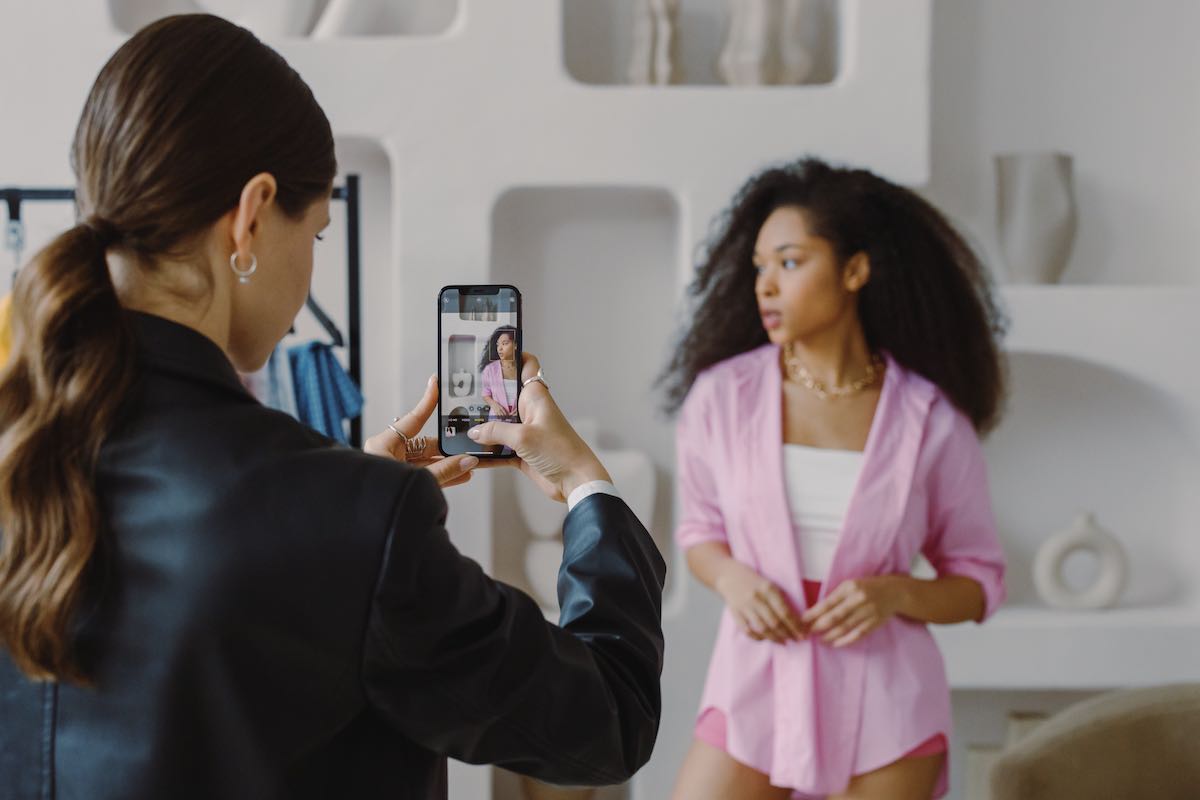If you are wondering how to enter the world of content creation, know that you’re not alone. Content creation has become one of the most popular career paths for many people, and for a good reason. “Creator economy” is valued at $100 billion, and the numbers are growing each year as the demand for new content increases.
Big companies are looking for in-house content creators to help with their digital marketing needs, and brands are looking for content creators to collaborate with as influencer marketing continues to be an efficient marketing strategy.
So, if you’re interested in becoming a full-time content creator, we have put together a quick guide with essential information about what it means to be a digital content creator and how to become one in eight easy steps.

What exactly is a content creator?
A content creator is a person that creates educational and entertaining content in one or more formats – written, audio, video, and visual for a target audience and shares it on digital platforms. Anyone posting pictures and videos on social media platforms or writing blog posts for their personal blogs can be considered a content creator, but a professional content creator is someone who is able to monetize their content.
Also, there are different business models for content creation:
- Freelancer: a professional marketing content creator who creates written, audio, video, and visual content for their clients.
- In-house creator: a content creator who is working full-time for a company or agency, creating content for them (think Buzzfeed content creators who are crafting content for Buzzfeed YouTube channel and website).
- Influencer: an independent content creator who is creating content for their platforms and monetizing it through brand sponsorships.
- Entrepreneur: a small business owner who is creating and selling digital products like online courses, ebooks, workbooks, etc., for their target audience.
What does a content creator do?
- Content creator job can include many different creative tasks like:
- Brainstorming and coming up with creative ideas
- Building engaged online communities
- Managing content calendars
- Writing guest blog posts
- Doing guest podcasting
- Filming and editing videos
- Writing and editing social media posts, blog posts, magazine articles
- Managing social media channels
- Producing podcasts
- Collaborating with brands on sponsored content
- Creating online courses and other digital products
- Working with clients
Most often, being a social media content creator requires wearing many different hats. It’s a very creatively-heavy and dynamic job that requires an interest in various subjects and skills that complement each other, for example, photography and video editing, or writing and social media management.
How much do content creators make?
How much money content creators make on average varies greatly amongst creators. The income will depend mostly on which business model you choose as a content creator – whether you’re freelancing, working for a company in-house, creating your own digital products, or working with brands on creating sponsored content.
Glassdoor reports that the median yearly content creator salary in the US is $48,000. But according to Influencer Marketing Hub, 2 million top content creators make six-figure salaries. So, the sky is the limit when it comes to how much content creators can make.
To understand better how content creators’ incomes vary, let’s look at a few examples of creators in different niches:
- Jessica Lynn is a content creator who writes articles on Medium on topics ranging from relationships, family, and politics to what it’s like to be a content creator. She makes between $5,000 and $7,000 every month from the platform.
- Pat Flynn is a well-known content creator who sells online courses, has a podcast, and is a published non-fiction author. His niche is online business and making money, and with his content, he makes well over $100,000 every month.
- Sorelle Amore is a minimalist travel YouTube content creator who made over $300,000 in her first year of being a full-time content creator from brand sponsorships, YouTube AdSense, and her photography courses.
Related post: How to find brand collaborations
How to become a successful content creator in 2024

Step 1: Choose a skill to master
While being a digital content creator will require you to have multiple skills to build your business and monetize it, start with choosing one skill to master at the start. That skill can be anything from:
- Writing/copywriting
- Social media
- SEO and Google Analytics
- Photography
- Videography
- Graphic design
- Illustration
- Audio production
Some skills might be easier to learn than others. And, you might already have a skill you can use to craft high-quality content, like writing or photography, which will make it easier for you to start. Once you choose one skill to focus on, you’ll be able to excel at it and monetize it in different ways with time. And of course, your unique skill or niche area of interest may not fall into the above—and that’s OK! You can still hone it and create content.
For example: If you choose video production because you want to start a YouTube channel, as you improve your video production skill, you will be able to start working with clients and brands, producing content for them either as an in-house creator, freelancer, or even as an influencer as you grow your audience.
Step 2: Pick a niche you are passionate about
Pat Flynn started his first content creation business by creating exam study guides for architecture students. He had just passed the architecture exam and wanted to share the method that he knew works with other students. It was a small niche yet very effective, and it allowed him to build his first online business.
So, when you’re ready to start creating content, you have two roads ahead of you:
- Picking a topic/niche that you already have knowledge or expertise in
- Choosing a topic/niche you’re passionate about
If you, like Pat Flynn, choose the first option, creating content and coming up with content ideas will be easier at the start. You’ll be able to write blog posts or produce podcast episodes faster and more efficiently because you already know the topic well enough. And, your knowledge of the subject will allow you to present as an expert in the field, helping you build credibility.
Another way is to choose a niche or a topic that you’re passionate about and interested in developing knowledge in. When you are interested in the topic you’re creating content on, you’ll be more inclined to stick with it, and you won’t get bored even after hundreds of hours of writing or talking about the subject. There’s frequent overlap between these two routes, so go with your gut and know that regardless of what you choose, there are endless niches that are easily monetized.

Step 3: Choose your business model
As we already discussed at the start, you can structure your content creation business in many different ways. If you already have expertise in a niche and a skill, like writing, you can start by being a freelancer or working as an in-house content creator for a company or an agency. To find in-house content creator jobs, go to Google and type in “content creator jobs” and see what postings are available.
If you decide to go the freelance writing route, then you’ll need to find clients. You can either apply to jobs on online marketplaces like ProBlogger. Or, simply Google businesses in your niche, make a list of ones you want to work with, and then cold pitch them asking if they need help with their content marketing.
Not everyone will want to choose these business models. Maybe taking the entrepreneur route and creating your products is more up your alley. Or maybe, you always wanted to create lifestyle content and be a social media influencer. Think about which content creation model is the right one for you.
Of course, you can tap into the creator economy yourself through online courses. Online courses and coaching allow you to be in control over the content you share—and how you monetize it. With Teachable, everything you create is 100% yours always. We give you the easy-to-use tools and features you need to share your passion and knowledge in a way that makes sense for you and your audience.

{{pricing-component="/blog-shortcodes/blog-cta"}}
Step 4: Build your cotent portfolio
Finally comes the fun part—content creation! To become a successful content creator, you’ll need great good quality content that people want to consume. And the best way to learn to create this type of content is by creating a lot of content.
The first step will be to pick a platform. We recommend picking one at the start that compliments your niche and chosen skill set well:
- Best platforms for video production: YouTube, TikTok, Instagram
- Best platforms for writing/copywriting: WordPress blog, Medium, Substack, Instagram, Twitter
- Best platforms for audio: TikTok, YouTube, Instagram.
- Best platforms for graphic design/illustration: TikTok, Instagram, Twitter
- Best platforms for photography: Instagram, TikTok
- Best platform for online course and coaching: Teachable
Once you choose a platform or a few on which you want to create content, your next step will be brainstorming ideas and creating a content calendar. It will allow you to plan and prepare to create intentional content and help build your credibility as a successful content creator.
Creating content will require more energy and time at the very start of your journey. You might not always be happy with the results, and that’s okay. The key here is to create enough content pieces to get you the experience and make you excellent in what you do, allowing you to grow and monetize your content creation business.
Step 5: Find your unique voice
No matter which niche you’re in or which format of content you choose to create, finding the thing that makes you unique is crucial for your success. One thing that all great content creators have in common is that they each have something that makes them stand out in a crowd.
As you create your content, think of how you can craft content that stands out from other creators. For example, if you’re a beauty blogger, try to stand out by writing long-form blog posts on a topic instead of crafting short articles. Or, maybe try to add your unique tone of voice every time you write, allowing your readers to recognize you.
If you’re creating a piece of content for TikTok, experiment with different trends and video formats to create something that has the potential to appeal to many people but is a bit different than what the rest of the creators are doing. Due to the nature of the app, good content goes viral quickly, and if you manage to create unique digital content, your chances of it happening are higher.

Step 6: Build an engaged community, online and IRL
If you choose to take the influencer or entrepreneur route, you’ll need to build an engaged community interested in your content. The side of your audience is not the focal point. The key here is to build an engaged audience that consumes your content and is a superfan of what you create.
And the best way to build an online community that’s interested in you as a content creator and what you have to offer is by identifying who your target audience is. You can do that by answering these questions:
- How old is my target audience?
- Where are they based?
- What is their relationship status (single, married, divorced)?
- What are their interests?
- What brands do they follow/interact with?
- What are their values?
- Where do they spend their time online?
- How familiar are they with internet culture?
The more in-depth and in-detail you go with identifying your target audience, the better it is. Knowing who you are talking to when creating content and what language your audience responds to will allow you to stand out in the crowd and connect with them.
Once you have built an engaged online community, you’ll be able to take your content creation business to the next level. And the easiest way to do that is by creating digital products that help improve your target audience’s lives. This brings us to the next step in your journey.

Step 7: Leverage your knowledge and life experience to create an online course
One of the most common questions people have when trying to find out how to become a content creator is how to monetize their content. The easiest and most efficient way to monetize your content when you have an engaged online community is by creating digital products like ebooks, workbooks, and online courses. Online courses are the best option because they allow you to charge a premium price for your expertise without you having to directly exchange your time for money.
Here is your quick step-by-step guide for creating an online course:
1. Identity what your audience needs
Best online courses sell a transformation to people. It can be anything from learning how to draw fashion illustrations, bake sourdough bread, make shoes or get healthy.
Throughout your journey as a content creator, you’ll start noticing the specific pain points your audience has. Make a list of them, and then see what sort of transformation you can offer with your online course.
2. Test your idea
An efficient strategy for launching an online course is to do a soft launch that includes announcing a pre-sale for your course before you start creating course material. This strategy allows you to validate your idea and ensure that you’re not creating something in which your audience has no value.
When you have a solid online course idea in mind, announce it to your email list, inviting people to pre-order. It’s also a good idea to post your pre-order on your social media channels or Facebook group if you have one. Once you see people pre-ordering, you know that your idea is valid, and it’s time to start creating!
3. Build the course
Content creation is something you have already been doing and love! First, you’ll want to create a curriculum for your course and map out your content. When it comes to lessons, remember that less is more, and the most important thing is to map out the journey for your students from start to finish.
Once you have a curriculum, you’ll want to consider the types of content your online course will include. Different people will prefer different types of content, so you’ll want to consider including written, audio, and video content for the most optimal experience.
4. Launch and market your course
The launch of your online course is always exciting and fun. But this is also where you’ll have to give your content creator hat a break and put on a marketer hat because your launch and after-launch period is when you want to seriously dig into marketing your course.
Consider these marketing strategies:
- Run an email campaign
- Do guest podcasts
- Write guest blogs
- Do live webinars
- Post on your social media accounts
To learn more about online courses, check out the in-depth guide on how to create an online course.
Step 8: Diversify your income
As a content creator, you’ll want to diversify your income as you progress further into your career. This will become easier as you gain experience and build your reputation as an expert in your field. Because of how dynamic this job is, many different opportunities await you.
If you started as a freelancer or in-house content creator but have been working on creating YouTube content, you might want to branch out and start working with brands on sponsored deals as your audience grows.
Sorelle Amore turned her YouTube audience’s interest in her “Advanced Selfies” into a profitable online course business. At the start, she created YouTube videos of her travels and how she takes photos of herself on solo travels.
Once she noticed people’s interest, she launched an online course that helped her rack up the $300,000 in her first year as a full-time content creator. Then, to further diversify her income, Amore branched out to working as an influencer and collaborating with brands like Porsche to create sponsored video content for her channel.
As you can see, diversifying your income as a creator is easy once you get more experience and exposure and build your name and online audience.

How to become a content creator on Instagram
While the general guidelines for becoming a content creator can apply to all the various platforms, there are more nuanced ways to show up depending on the platform that can bring you more success. It’s important to note that the algorithms for each platform, especially Instagram, are constantly changing. The main goal of instagram’s algorithms are focused on engaging users with relevant content in order to increase their time spent on the app. This is based on the user’s past history when it comes to what kind of content they’re engaging in (posts, stories, reels, videos), who is posting it, and how likely they are to engage in the content. The more likely it is that users will engage with your content, the more your posts will be prioritized in a user’s feed.
In other words, it’s important to invite your audience to interact with what you’re posting. Invite them to “double tap” a post if they agree with the caption/text, ask an engaging question so that people will comment with their opinion or answer, or have a call to action for them to click the link in your bio.
This can feel like a catch-22, because how will people engage with your content if it’s not being shown as much? This is where it’s important to stay consistent, because the more you post relevant content, the more likely it will be engaged with, and the more it will be shown to people. Stick with it—slow and steady wins the Instagram race!
How to become a content creator on TikTok
While TikTok also prioritizes content based on engagement, it’s a slightly different game than the other platforms. With TikTok, it’s all about the FYP (“For You Page”). Some of the most important factors that this app’s algorithms take into account are the subject material of the video, trending sounds that are being used, location, and watch time/rewatches.
The more views a video is garnering, the more it will be shown on other’s For You Pages. This makes it a bit easier to go viral on TikTok, and that can happen fast on this app, with some videos getting millions of views in a matter of days.
Just as with other platforms, it’s crucial to create content from the perspective of what will get the most engagement from your audience. You can boost engagement (and the chances of your videos getting seen more!) by using trending sounds, and making shorter videos—when they’re shorter, they’re more likely to loop. This registers as an increase in watch time, and will push your content out to a wider audience. It’s also relevant to start with an attention grabber, because much of the content on the app is very short form, people are faster to scroll away if it doesn’t pique their interest right away.
It’s important to stay patient with this platform as well, since your videos can start (or continue!) to go viral days or even weeks after posting them.

FAQs
What qualifications do I need to be a content creator?
You may be relieved to know that there are no official qualifications required to become a content creator. While there are a plethora of courses, coaches, and content that focus on how you can do this, you don’t need to partake in any of those. All you need is a willingness to be visible, consistent, and to have awareness of navigating common experiences like imposter syndrome, burnout, and prioritizing mental health as a creator. It’s also helpful to familiarize yourself with skills like video editing, photography, and copywriting. Don’t worry about needing to master these before starting though, many of these skills just come with time and practice!
Do content creators get paid?
This varies from creator to creator, but in a lot of cases, it’s entirely plausible to monetize your content. This can be done through being a brand ambassador, marketing your courses, or through other aspects of being a digital creator, like virtual offerings and/or coaching. Some platforms like Instagram and TikTok even offer financial incentives to post . There are many income streams that can open up to you as a content creator, including brands approaching you. As this process unfolds, there will likely be a varying length of time in the beginning where you aren’t getting paid, so be sure to plan for that!
Is being a content creator worth it?
This is a highly personal and subjective answer. In order to understand how this would apply to you, get clear on what it is you’re looking to get out of it. If you’re solely looking to make money, then it can be hard to predict if and when it would be deemed “worth it.” However, if your aim is to make money and make a positive impact with your content and to enjoy the creation process along the way, then it’s absolutely a worthwhile endeavor.
It’s also helpful in this case to choose a niche that you care about, as opposed to choosing it solely on how lucrative it has the potential to be. People will be able to sense if you’re genuinely excited and interested in the topics that you’re sharing about—and that can be a determining factor when it comes to them engaging with your content or buying from you.
Additional reporting by Nicole Quintana-Wolf
Join more than 150,000 creators who use Teachable to make a real impact and earn a real income.







